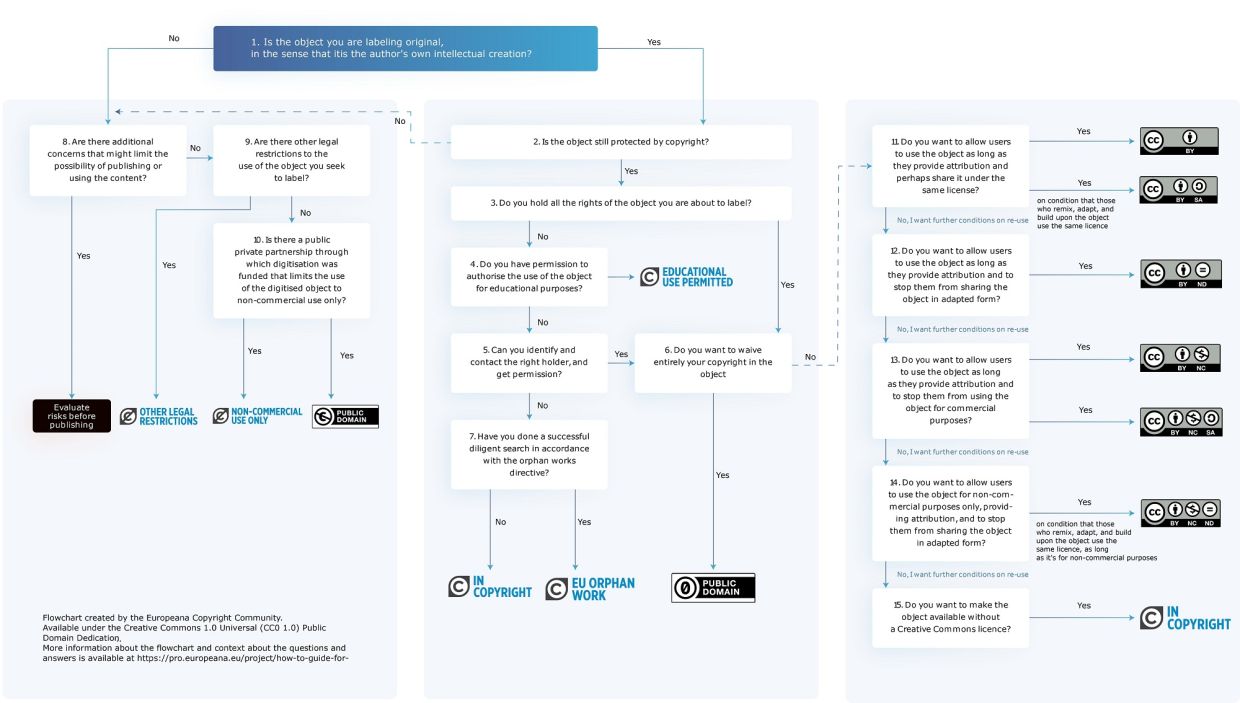How to select an accurate rights statement
This page offers information on how to identify the most accurate and adequate rights statement for the data you share with Europeana.
This page offers information on how to identify the most accurate and adequate rights statement for the data you share with Europeana.
The information on this page is based on the list of available rights statements that Europeana works with as part of its Licensing Framework. Before reading this page, we encourage you to read our information about the available rights statements used by Europeana.
We also offer a training course on how to select an accurate rights statement through the Europeana Training Platform, part of the Europeana Academy. Register for the course.
We believe that everyone should have access to cultural heritage online. And for users to know how to use digital objects, providing clear and simple rights information is essential. That is why digital objects submitted to Europeana must include a rights statement from one of the 14 options that Europeana works with.
Just using rights statements is not sufficient to facilitate reuse: the choice of rights statement has to accurately reflect the copyright status of the object, as well as other considerations. Europeana data providers have an obligation to make ‘best efforts’ to provide Europeana with correct rights information, as described in the Data Exchange Agreement.
For example:
Here are a few tips that should help you make an accurate choice of rights statements.
By using a Creative Commons Licence or CC0, you are giving people permission to use the material. A cultural heritage institution should not use this unless they have cleared all the rights and have the agreement from the rightsholder.
Consider whether any other legal or contractual conditions apply. By determining that, you will know if you need to apply the No Copyright - Other Known Legal Restrictions Right Statement, or the No copyright - Non commercial Use Only Rights Statement. For instance, was the object digitised through a partnership with a private actor and does the agreement forbid commercial reuse?
The approach for making such decisions will change from one organisation to the next, so within the accurate choices that you have, also remember to consider your organisation's policy for sharing content, and whether there is a willingness to open up, which we encourage.
The flowchart below can guide you through making an accurate and adequate choice of rights statements (access it in high resolution here). You will also find more information on how to accurately select a rights statement in this Task Force report.

Many institutions distinguish between rights to the content and rights to the digital object (see the respective definitions on this page). However, when you share data with Europeana, we encourage you to treat them as one to make it easy for users to assess if they can use what they see. This means choosing one rights statement that applies to both the content and the digital object. We describe how this can be done below.
The simplest way to ensure that the rights information of the ‘physical’ object and the digital object coincide so is by not claiming additional rights that may result from the digitisation of content. This is something that we particularly encourage you to do in works that are in the public domain, as described in our Public Domain Charter.
In any case, rights on the reproduction of a public domain work can only be legally claimed in a few circumstances, as described in this post.
If you still differentiate between two layers, for instance because a photographer digitised sculptures in a way that makes their photographs original, here is what you should consider to choose a rights statement that accurately reflects both the content and the digital object:
If the content is protected by copyright, but the digital reproduction is not, the rights statement should communicate the in copyright status (through a Creative Commons License, or an In Copyright Rights Statement).
If the content is not protected by copyright, but the digital reproduction is (and you wish to claim the rights), the rights statement should communicate the in copyright status (through a Creative Commons License, or an In Copyright Rights Statement).
If neither the content nor the digital reproduction are protected by copyright, the rights statement should communicate the out of copyright status (through the Public Domain Mark or an Out of Copyright Rights Statement).
If you wish to know more about how to technically submit a rights statement to Europeana, you can read about it on this page.